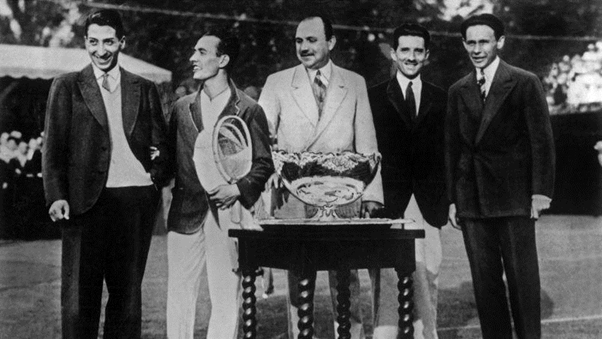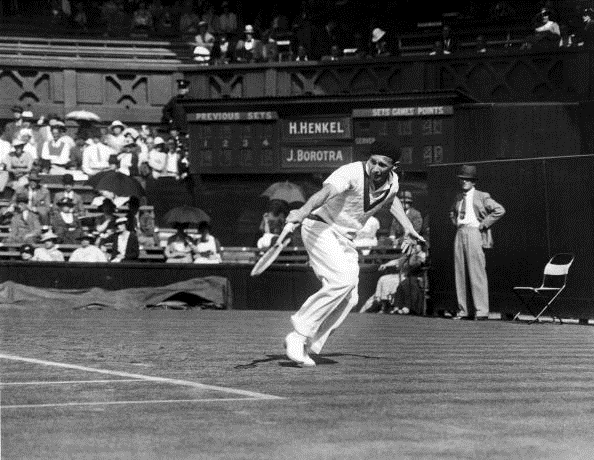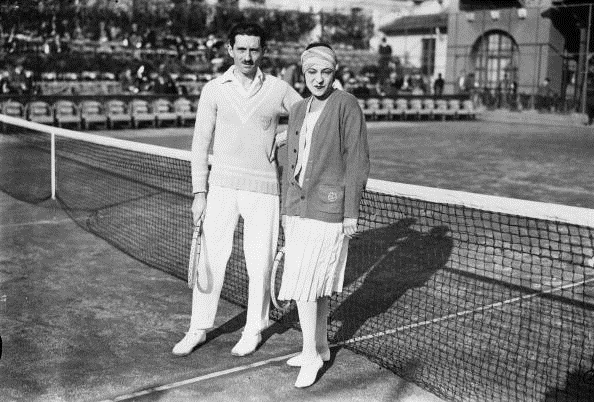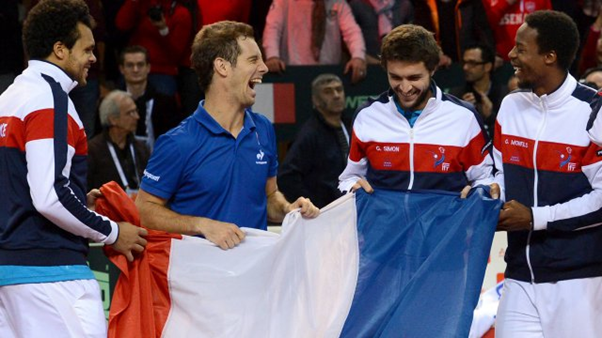The Four Musketeers - Jean Borotra, Jacques Brugnon, Henri Cochet and René Lacoste dominated the late 1920's and early 1930's going on to win 20 Grand Slam singles titles and 23 doubles titles. They also won six straight Davis Cup titles from 1927-1932.
While Brugnon was primarily a doubles specialist, Borotra, Cochet and Lacoste claimed many singles titles amongst the three. Between them, they managed to win the US Open at Forest Hill three times, while at Wimbledon on the grass at the All England Club, they won six consecutive titles from 1924 to 1929.
At the French Open, their home grand slam, they dominated winning ten titles in 11 years from 1922 to 1932. From 1924, the French Open was only open to the French players but in 1925 it became a major tennis tournament. From 1926 to 1930, two of the four musketeers - Cochet and Lacoste were ranked number one and in 1926 and 1927 all four of the Musketeers were ranked inside the world's top ten.
Dominance under threat
Despite their dominance throughout the 20's and early 30's, their reign was becoming under threat by an American named Bill Tilden, who was at the time the only player capable of splitting the French foursome and mounting a challenge. However, the French were eventually overtaken by the arrival of three new Tennis players - Ellsworth Vines, Fred Perry, and Jack Crawford on the international tennis scene in the first half of the 1930s.

Legacy
The four players left behind a lasting legacy. After defeating the USA in the 1927 Davis Cup Final, the French Federation decided to build the Roland Garros venue at Porte d'Auteuil. The Musketeers at the time were national heroes who all lived to at least 83 years of age. In 1976, the foursome was inducted into the Tennis International Hall Of Fame in Newport, Rhode Island. Following their success French tennis never was the same, despite producing a number of players.
Jean Borotra
Borotra, more known as "The Bounding Basque." This was because of his acrobatic skills and swift movement across the court. In his playing days, he managed to win 19 Grand Slam titles including singles, doubles, and mixed doubles. Borotra played for the Davis Cup team in 1922, 1924-37 and 1947. Borotra was only one Grand Slam title away from completing the career boxed set but failed to win the US Open. In 1926, he reached the final at the US Open but could not capture the famous title.

Borotra, who won 69 titles and 19 Grand Slams never held the world number one spot, instead, his highest position in the rankings was world number two. achieved in 1926. However, in doubles, he was world number one, back in 1925. The International Fair Play committee which annually recognises achievements of the players, hands out the “Jean Borotra World Fair Play Trophy.”
“The only possible regret I have is the feeling that I will die without having played enough tennis.”
Jacques "Toto" Brugnon
Jacques "Toto" Brugnon, considered to be one of the best doubles players to ever grace the game was the French Davis Cup Captain for six years. In 1921, Brugnon captured his only Grand Slam title at the French Open. However, in doubles, he won ten Grand Slam titles and two Mixed Doubles with the famous Suzanne Lenglen, who has a court named after her at the French Open today.

Brugnon played at Wimbledon on 20 occasions, with the 1926 championships being his best result, a semifinalist. He achieved his highest ranking of number nine in the year of 1927. Before retiring, Brugnon played at Wimbledon for the last time, hanging up his racket at the end of the tournament.
Rene Lacoste
Rene Lacoste, more famously known for his brand "Lacoste". In 1927, in one of the Davis Cup tournaments, France's Davis Cup Team Captain made a wager with Lacoste. The stake held was a crocodile-skin suitcase if he had managed to win a certain match.
Lacoste did win the suitcase but was also later given a blazer which had the crocodile logo embroidered on it. In many of his matches prior, he would often wear the blazer. As a result of this, Lacoste introduced the now famous, Lacoste Tennis Shirt.

Along with being called "The Crocodile", Lacoste was also famous as the "Tennis Machine". This was because he was well known for his tactical baseline game. He was ranked number one during the 1926 and again during the 1927 season. Overall, he managed to win seven singles titles and three doubles titles. In 1927 and 1928, he was part of the France Davis Cup team.
Henri Cochet
The son of a groundskeeper served as a ball boy. He used to practice the sport of Tennis during his spare time. He was known as the "Ball Boy of Lyon" decades later.
He achieved the number one spot in 1928 all the way up till 1931. Throughout his career, Cochet won a total of 53 singles titles. Those included five French Open titles, two Wimbledon titles and one US Open title. Henri Cochet was also an exceptional doubles player.
Cochet won three French Opens and two Wimbledon titles in the doubles category partnering Jacques Brugnon. Cochet won three Mixed Doubles Grand Slam titles along with Eileen Bennett.

The Frenchman is probably best known for coming back from two sets down in his quarterfinal, semifinal, and final match before going on to lift the title in 1927. In his quarterfinal match, he was trailing 5-1 in the third set with Bill Tilden serving for the match.
After levelling at 15-all, Cochet went on an impressive run, going on to win 17 straight points to eventually take the set 7-5. He then went on to win the next two sets and became part of the most heroic effort in Tennis' history.
Roland Garros
Back in 1927, a group of French tennis players known as the French Musketeers — or as they were called in France, Les Mousquetaires — beat the USA for the first time to win the Davis Cup.
Suddenly, the French needed to build a stadium of their own — quickly. The stadium was to be built outside of Paris. Part of the negotiation for the land to build the stadium was predicated on naming the finished tennis arena after a World War I soldier. The soldier chosen was aviation hero Roland Garros.
Coupe des Mousquetaires
La Coupe des Mousquetaires (English: The Musketeers' Trophy) is the trophy awarded to the winner of the Men's Singles competition at the French Open.
The trophy was created in its current form in 1981, after Philippe Chatrier, then president of the Fédération Française de Tennis (FFT), offered jewellers the opportunity to redesign it. It is supposed to symbolise the victories of four famous French tennis players, who together make up the "Four Musketeers": Brugnon, Borotra, Cochet, and Lacoste.
Current Four Musketeers
In the current tennis era, the French Press named The New Musketeers: Jo-Wilfried Tsonga, Richard Gasquet, Gael Monfils and Gilles Simon. Since the computer rankings were established in 1973, the first time that four Frenchmen made it to the top 20 rankings occurred in 2008. In addition, the same four players repeated this feat in mid-2011, early 2012 and early 2016.











































